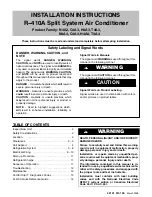
INSTALLATION INSTRUCTIONS
R-410A Split System Air Conditioner
421 01 5101 00
11
START-UP PROCEDURE
1.
Set indoor thermostat selector switch to OFF.
2.
Turn ON all electrical disconnect devices.
3.
If unit has a crankcase heater, energize the heater
and wait 24 hours before proceeding.
4.
Set indoor thermostat at desired temperature. Be
sure setpoint is below indoor ambient temperature
or thermostat will not call for cooling.
5.
Set indoor thermostat selector switch to COOL.
Operate unit for minimum 15 minutes, then check
the system refrigerant charge.
REFRIGERANT CHARGE
Outdoor units are shipped with a refrigerant charge to
match a specific indoor coil and 15 feet of refrigerant line.
If shorter or longer refrigerant lines or a different indoor
coil are used, the charge will have to be adjusted.
For different line lengths, add or remove charge based on
0.6 ounces charge per foot of difference. For example, a
25 foot line set is 10 feet longer than the specified 15 feet.
Add 0.6 ounces charge for each of the extra 10 feet:
10 x 0.6 = 6.0 ounces additional charge
This outdoor unit is designed for use only with indoor coils
that utilize a TXV refrigerant metering device. With an
indoor TXV, use the subcooling method to make final
charge adjustments:
NOTE:
Only use subcooling charging method when
S
outdoor ambient temperature is between 70
_
F and 100
_
F
S
indoor temperature is between 70
_
and 80
_
F
S
line set is less that 80 feet.
1.
Operate unit a minimum of 15 minutes before
checking charge.
NOTE:
If outdoor unit has a 2-speed fan motor,
motor will operate in low speed when outdoor
ambient temperature is below 82
°
F. Pull one of the
yellow low voltage wires off the fan control and the
unit will default to high speed fan for servicing.
Reconnect wire after servicing.
2.
Measure liquid service valve pressure by attaching
an accurate gauge to service port.
3.
Measure liquid line temperature by attaching an
accurate thermistor type sensor or electronic
thermometer to liquid line near outdoor coil.
4.
Refer to unit rating plate for required subcooling
temperature.
5.
Refer to Figure 10. Find the required liquid line
temperature where the rating plate subcooling
temperature intersects measured liquid service
valve pressure.
6.
If the measured liquid line temperature is higher
than the chart number, add refrigerant to lower the
measured temperature.
NOTE:
When adding refrigerant, charge in liquid form,
using a flow restricting device, into the suction port.
If the measured liquid line temperature is lower than the
chart number, reclaim refrigerant to raise the measured
temperature.
Tolerance is
3
°
F.
Figure 10
R-410A Required Liquid Line Temperature (
°
F)
Measured Liquid
Pressure (psig)
Rating Plate (required)
Subcooling Temperature (
°
F)
Measured Liquid
Pressure (psig)
Rating Plate (required)
Subcooling Temperature (
°
F)
6
8
10
12
14
16
6
8
10
12
14
16
251
78
76
74
72
70
68
364
104
102
100
98
96
94
259
80
78
76
74
72
70
374
106
104
102
100
98
96
266
82
80
78
76
74
72
384
108
106
104
102
100
98
274
84
82
80
78
76
74
395
110
108
106
104
102
100
283
86
84
82
80
78
76
406
112
110
108
106
104
102
291
88
86
84
82
80
78
416
114
112
110
108
106
104
299
90
88
86
84
82
80
427
116
114
112
110
108
106
308
92
90
88
86
84
82
439
118
116
114
112
110
108
317
94
92
90
88
86
84
450
120
118
116
114
112
110
326
96
94
92
90
88
86
462
122
120
118
116
114
112
335
98
96
94
92
90
88
474
124
122
120
118
116
114
345
100
98
96
94
92
90
SEQUENCE OF OPERATION
With power supplied to indoor and outdoor units,
transformer is energized.
On a call for cooling, the thermostat makes circuits R-Y
and R-G. Circuit R-Y energizes contactor, starting
outdoor fan motor and compressor. Circuit R-G
energizes indoor unit blower relay, starting indoor blower
motor.
When thermostat is satisfied, its contacts open,
de-energizing contactor and blower relay. Compressor
and motors stop.
NOTE:
If indoor unit is equipped with a time-delay relay
circuit, the blower runs an additional length of time to
increase system efficiency.














